Do you have a question about the Wood-mizer LT40 and is the answer not in the manual?
Safety precautions for handling bandsaw blades.
Instructions and warnings for setting up the sawmill.
Safety guidelines and procedures for operating the sawmill.
Electrical safety checks and maintenance procedures.
Lists belt sizes and part numbers for LT30/LT40 sawmills.
Recommended blade types and dimensions for various wood sawing.
Log size capacities and performance rates for LT30/LT40 sawmills.
Details engine and motor options available for the sawmills.
Lists overall dimensions and weights for LT30/LT40 models.
Identifies major components of the LT30, LT40, LT30 Super, and LT40 Super.
Instructions for setting up the sawmill on a stationary base.
Instructions and warnings for setting up the portable sawmill.
Step-by-step guide for safely replacing the bandsaw blade.
Procedure for correctly tensioning the bandsaw blade using the gauge.
How to adjust the blade to ensure it tracks correctly on the wheels.
Safety precautions and steps for starting the sawmill's engine or motor.
Procedures for safely loading, turning, and clamping logs on the sawmill bed.
How to operate the up/down controls for the cutting head.
Adjusting the blade guide arm for optimal cutting performance.
Instructions for engaging and disengaging the clutch and brake system.
How to use the power feed system for carriage movement and speed control.
Step-by-step guide for cutting logs with the sawmill.
Process for edging boards on the Wood-Mizer sawmill.
How to use the sight gauge for setting blade height.
Description of the blade height scale and its components.
How to operate the water lube system for blade cleaning.
Steps to prepare the sawmill for safe transportation.
Estimated life expectancy of common replacement parts.
Maintenance procedures for blade guide rollers, including lubrication and checks.
Cleaning and adjustment procedures for the blade housing.
Cleaning and lubrication of carriage track, wipers, and scrapers.
Cleaning and lubrication of vertical mast rails to prevent rust.
Lubrication procedure for up/down and power feed drum switch contacts.
Lubrication tasks for blade guide arms, side supports, and chains.
Lubrication of the blade tensioner system components.
Procedures for checking and maintaining blade wheel belts.
How to check and adjust the brake strap for proper stopping.
Refilling fluid in the drive-side cylinder bearing housing.
Maintenance for the up/down gear reducer shaft bearing and chain.
Adjusting the power feed belt and chain tension.
Checking mill alignment and safety warning decals.
Common sawing issues and their solutions.
Troubleshooting common electrical issues with the sawmill.
Solutions for problems related to the power feed system.
Using LED lights on the circuit board to diagnose feed problems.
Steps to align engine/motor and drive pulleys for proper operation.
Initial steps and overview for aligning the entire sawmill.
Procedures for setting up the sawmill frame for alignment.
Steps for installing and aligning the sawmill blade.
Adjusting the nylon slide pads on the saw head.
How to adjust the lower track rollers for accurate cuts.
Adjusting bed rails to ensure they are parallel to the blade.
Adjusting the vertical tilt of the blade guide arm.
Adjusting the horizontal position of the blade guide arm.
Steps to align the blade guide assemblies for a straight cut.
How to achieve proper blade deflection using the blade guides.
Ensuring the blade guide does not tilt the blade up or down.
Adjusting the spacing of the blade guide flanges from the blade.
Adjusting the horizontal tilt of the blade guide rollers.
Horizontally adjusting side supports for square cuts.
Vertically adjusting side supports to be perpendicular to bed rails.
Adjusting the clamp stop to touch a reference string.
Calibrating the sight gauge to accurately show blade position.
Compensating for saw head drop when cutting wide logs.
Adjusting the blade height scale for accurate readings.
| Max Log Diameter | 36 inches |
|---|---|
| Blade Length | 158 inches |
| Blade Width | 1.25 inches |
| Max Width of Cut | 28" (71 cm) |
| Engine Options | Gasoline or Diesel |
| Hydraulic System | Optional |
| Blade Size | 1.25 inches wide, 0.042 inches thick |
| Weight | Varies by configuration |
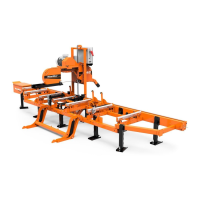
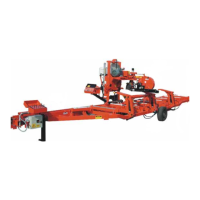
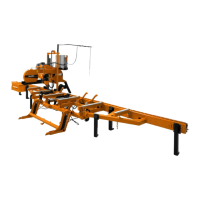

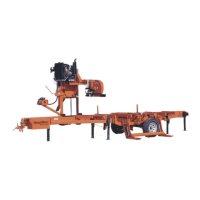
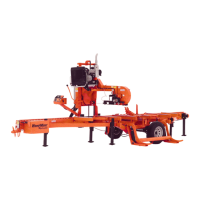

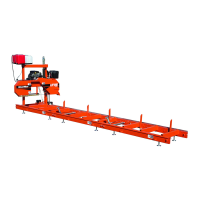

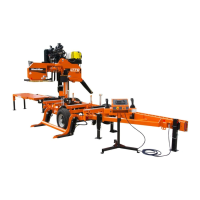

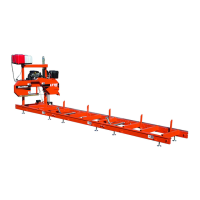
